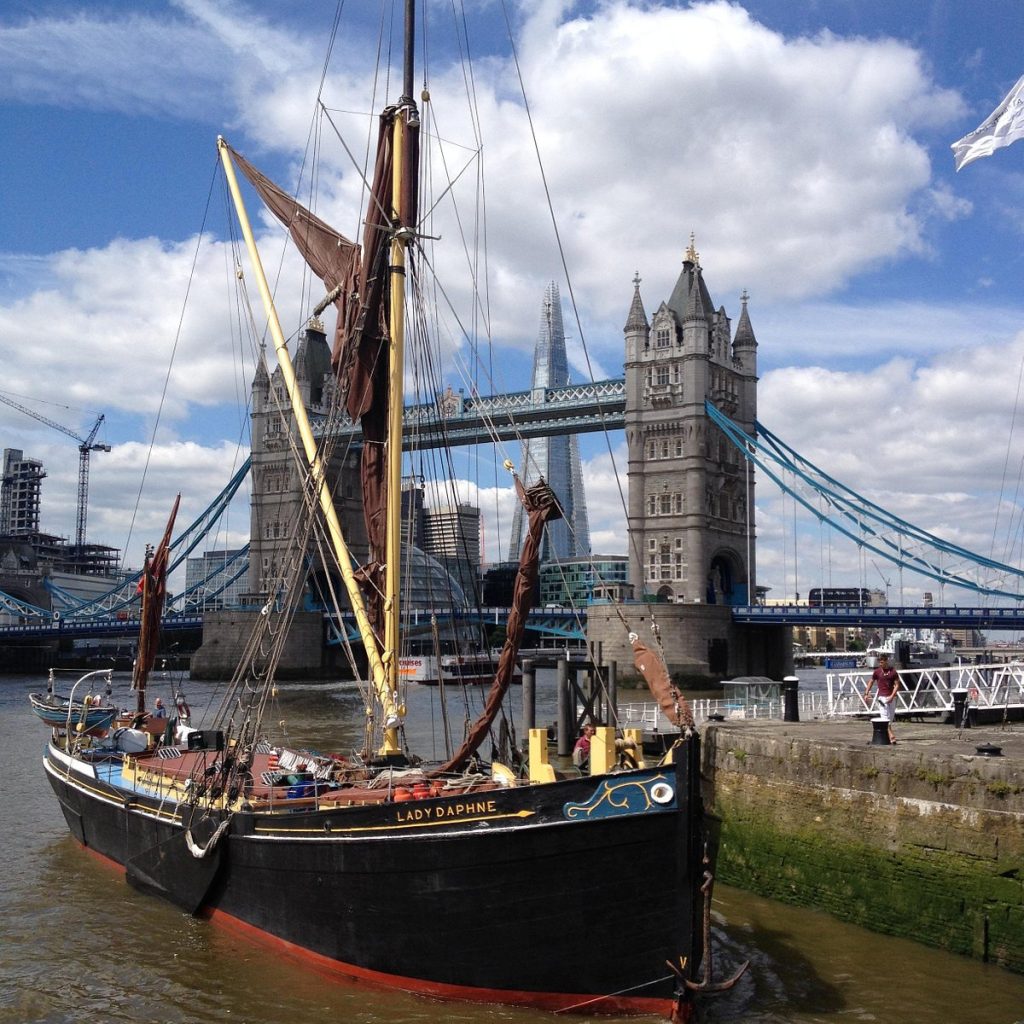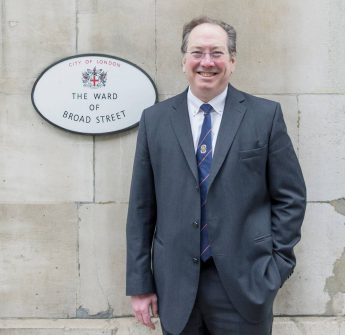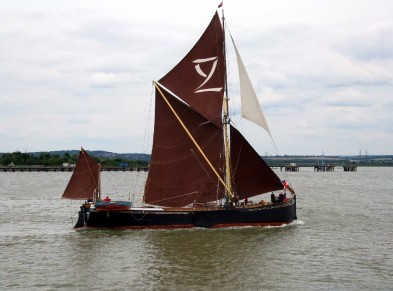Remarks to: the Company of Watermen & Lightermen‘s Freemen’s Lunch, Friday, 18 November 2022, Watermen’s Hall
Master, Wardens, Court members, fellow Freemen:
I may be our Master’s worst nightmare, a sailor with an audience who believes they might want to hear his nautical tales.
A touch of background, I’m a member of the Association of Bargemen, Sailing Barge Association, and Thames Sailing Barge Trust. I have been a trustee since 1999 of the world’s oldest sailing racing body, the Thames Match, as well as being a London Waterways Commissioner for eight years. On plastic boats I’m a long-standing racer and member of the Royal Ocean Racing Club who’s been round much of the North Sea and Baltic, from Muckle Flugga to the Fastnet to Goteborg. And I won’t bore with my background in rowing at Harvard, or on the Thames, and was thrilled to be rowed by some here on Gloriana in September’s Reflections Pageant.
I might observe that we Watermen have many tribes – rivermen, rowers, sailors, bargemen, and lightermen. The Master has asked me to represent the Heritage tribe today. Our heritage industry is often overlooked economically because the revenue numbers are small. Nevertheless, heritage businesses are proud custodians of the past, and seek to be economically sustainable to keep these vessels going in the future, not dependent on handouts or charity. My key point today is that we need to make Heritage businesses economically viable, and that some basic elements impede their already difficult task.
We have Thames watermen cutters, Havengore that carried Churchill’s coffin, David Suchet’s Leonie now owned by Freeman Stephen Bernard, and of course the score of extant Thames sailing barges. If you think about it, the heritage tribe was the Thames’ economy. The Joint Select Committee of Lords and Commons on the Port of London Bill of 1903 established that 75 to 80 per cent of the whole traffic of London was carried by barges.
Heritage boats create what economists call spill over or downstream benefits, by drawing people to the river, connecting traditions and instilling pride – heritage celebrates continuity and change. Heritage requires catering, support vessels, passenger vessels, cameras, drones, and creates publicity.
I have two barge riddles to keep your attention. Here’s the first:
“Where does the traveller sit on his horse? The answer you want is by the horns of course. Where would you sit?”
The horns are cleats at either end of our travellers, so you’d sit there and leave the mainsheet in the middle.
Speaking of barges, Lady Daphne is a 91 foot, 1923 wooden Thames sailing barge. 87 registered tonnes and 200 deadweight tonnage. Ray Bateman lent his model of Lady Daphne to the Company for twenty-five years, displayed in the chamber below. From 1996 to 2017 Elisabeth and I restored Lady Daphne, now in the hands of new owners also embarked on a two decade second restoration. I remember the day in the 90’s, shortly before my wedding when I bought Lady Daphne. As many here will know, the odds of buying any boat after your wedding are much diminished. On the Elizabethan last year for Master Gina Blair’s farewell event I shared the story of our first sea trial with my newly-minted wife.

Heritage is about stories, great stories about sailors under pressure. In May 1940 extraordinarily courageous crews manned an armada of 311 or more ‘Little Ships’, 113 trawlers, and 34 tugboats. The entire operation was conducted under ferocious fire from the Luftwaffe. Somehow, from 26 May to 4 June 1940, 338,266 soldiers were taken off French beaches by an ad hoc fleet pulled together from ports and rivers on the east and south coast.
Up to 58 sailing barges made the journey. I’ll focus on one, Ena. Ena was the inspiration for the sailing barge in the 2017 film Dunkirk. Ena made the 100-mile journey sailing through attacks and mines. After heroic work on the beaches, but with the German army closing in, Alfred Page, Ena’s skipper, was ordered to abandon his barge alongside another sailing barge, the HAC. The crew made good their escape back to England on a minesweeper.
No sooner had they left than thirty men of the Duke of Wellington’s Regiment arrived on La Panne beach. The Regiment had been fighting a desperate rear-guard action to keep the Germans at bay for as long as they could. They could not believe their luck when they saw two barges sitting there, in seaworthy condition. They took possession of HAC that afternoon, while Colonel McKay with men of the 19th Field Regiment, Royal Artillery boarded the Ena. Meanwhile, Captain Atley of the East Yorkshire Regiment, was on the mole at Dunkirk and together with one of his men, quickly made a raft. Using shovels, they rowed out to Ena and helped 36 other men on board including three wounded. By 8am both barges were under way.
In spite of enemy bombardment and machine-gun fire they raced across the Channel under sail, even though there were no experienced sailors on board.
Captain Atley recalls that by midnight they took a back-bearing on Dunkirk and found they had gone too far South-West. His only sailing experience had been on the Broads and he had forgotten to put the leeboards down. So they altered course to North-Northwest and finally sighted the North Goodwin buoy. They then had to tack again towards the South Goodwin lightship. Eventually, the Ena was picked up by a tug or fleet auxiliary and taken into Margate. Since the harbour was full, the empty barge was then towed out and left anchored off Deal. The shipping manager of R & W Paul, who had presumed the Ena lost on the beaches of Dunkirk, was amazed when he was told and asked what he proposed to do about it. Alfred Page, her skipper, by then back in Ipswich, was sent to recover her. He found the Ena seaworthy but stripped of all her gear. “They had taken the sweeps, mooring lines, fenders and even my false teeth which I had left behind in a glass of water by my bunk!” he said, “You can’t trust these men of Kent!” So he sailed her back to Ipswich.
Sailing Barge Xylonite portrayed this incident in the film. Of the 58 barges who participated in Operation Dynamo (Dunkirk), as well as in Cycle (Le Havre) and Aerial (French ports), 4 were sunk and 5 were lost. The HAC was later retired, and recently the Ena too, lying abandoned and derelict near Hoo on the River Medway.
It didn’t end there. The Admiralty needed all able craft and able-bodied crews for numerous deliveries. Wooden barges were particularly good for minesweeping. Nine humble barges lost to enemy action deserve mention alongside our warships – they were Aidie, Barbara Jean, Duchess, Doris, Ethel Everard, Lady Roseberry, Lark, Valonia, and Royalty. Barges and Little Ships are often one and the same.
Heritage stories bring the river to life, connecting past and future. But heritage craft face modern challenges and are often barely holding on.
Piers & utilities – Lady Daphne was used to deliver a ‘local knowledge day’ in March this year. She touched three piers on a Sunday for a combined bill of £250. Tower Pier is £50 for ten minutes. Water & electricity access are tough throughout the river. TfL have outrageously high insurance requirements for pier usage. They suit a fleet, or someone like me who can use connections to be in a P&I mutual, but not a single heritage vessel.
Regulation – I am a patron of the Sea Change Sailing Trust charity that chose to build and launch in 2016 a replica of Blue Mermaid, a 1930’s barge under cargo ship rules with Class Society GL, now taken over by DNV. Blue Mermaid does what a Thames barge was designed to do, sail cargo, today in aid of youth training. Plug for help: We are working hard with Essex Cement to find customers for high grade cement in London next spring. Anyone need any?
There is a growing Sail Cargo Alliance and so far it has used heritage vessels. Well-known is Tres Hombres which brings 50 tons of Caribbean produce across the Atlantic, as does De Gallant. Tres Hombres is flagged in Vanuatu, but flagging out is not possible for a UK coastal sailing barge.
Our leader, Executive Officer & Skipper Richard Titchener, whom you know provided me with a lot of the background to Blue Mermaid’s regulatory complexities that follows, much of which is similar to that Elisabeth and I experienced during our ownership of Lady Daphne.
Blue Mermaid is engineless, and interestingly was the first Gold Operator under the PLA’s Thames Green Scheme. The MCA talks about electricity, hydrogen, or ammonia for low or zero emissions, but seems to forget how sail worked. A rowed lighter starting at Gravesend at low water will take two tides to reach the capital, catching a turn halfway, free power. A sailing barge can do it in one tide, weather permitting, but such is the wash from speed and congestion in the upper reaches, it is now challenging to do so. A sailing barge and smack race finished at Cherry Garden Pier in 1977 as a Boeing hydrofoil left what is now HMS President for the continent and foiled from Wappingness at 30 knots. It made no wash. In Amsterdam or Venice they use 4 knot ‘effective wake’ fast boats, wave-eaters, Mangia Onda. If we truly appreciate our capital we need 4 knot ‘effective wake’ limits.
There is a long history of the MCA updating regulations for passenger craft that are hard for heritage vessels to meet. Watertight bulkheads, stability, inclination, load lines, and more. Surveyors have justifiable fears of old fabric. Owners are often the worst custodians. Fishermen were the first to cut rotten counter sterns off sailing smacks instead of rebuilding them. Marques, the 1984 loss of which created the push for codes under which we labour, was a perfectly good low aspect sailing vessel, successively built up to look the part in pirate movies to the point she fell over in a squall during a Tall Ships Race and 19 died. The loss of the Pamir in 1957 with the loss of 80 lives in weather she had survived many times before when properly loaded, ended square rigged sail training with cargo.
HQ in Southampton doesn’t apply the 1954 load line regulations (the last to mention sailing ships), so the closest stability regulation is the Large Yacht Code which has no concept of cargo but plenty else, some of it logical, some not. The use of this code led our surveyor to stipulate additional safety equipment costing over 10% of the charity’s annual revenue until we appealed to his good nature to apply the established Standard for Sailing barges under which we were already sailing. Protecting inanimate cargo required more and not less safety equipment than for children. The load line exemption was eventually granted in September 2022 after 38 months. Children’s accommodation also required exemption and it proved necessary to obtain a letter of support from the trade union Nautilus to state we were not a threat for diluting standards for seamen on modern vessels.
The current application of regulation does not bode well for the future of commercial heritage sail. The Recreational Craft Directive does exempt a number of craft from its provisions, including historic craft and replicas. The UK 2017 Regulations state, “original historical watercraft and individual replicas thereof designed before 1950 built predominantly with the original materials and labelled as such by the manufacturer”. Lest anyone should ask why exemption from the rules is needed, the alternative would turn a heritage ship complying with modern regulations into what Bob Roberts called “a bit of a factory that has fallen off and gone to sea” with one metre high coamings and rails. This is neither attractive or serviceable in a sailing barge. It’s not that we don’t have the capability to use common sense when awarding exemptions, it is our cussed unhelpfulness in using them against one other to avoid exactly what we need, special terms for special ships. We need a different and sensitive regime, while there is not much more than our community’s regulatory behaviours in the way.
As I stated, we can make Heritage economic. One part is selling the public and the industry on its value. Another part is removing unnecessary obstacles. Our Company can help with both.
Thames sailing barges are sailed by a man a boy and a dog, so try this final barge riddle:
“Look around the bow, you’ve much to gain. You don’t chain up the dog – the dog holds the chain. What am I?”
A cast iron hook holding a barge’s anchor chain while adjusting the chain on the winch barrel.
Anyway, a week ago today in the City I became Senior Alderman Below The Chair, SABTAC, and thus ‘subject to election’ possibly the next Lord Mayor on 10 November 2023, a role our Master knows far better than I. I intend to celebrate our river and am exploring several fun things that I would hope involve our Company ranging from a Thames Day, to our existing Sheriffs Ahoy!, but also perhaps an E1 powerboat race alongside our venerable Doggett’s Coat & Badge, perhaps trialling autonomous boats doing pallet deliveries from Dagenham to river restaurants, or a flotilla celebration of Old Father Thames, without whom London would have no purpose, that revives the Lord Mayor’s traditional visits to the Thames boundary stones at Staines, Chatham, Yantlett Creek, and the Isle of Grain.
Now, we scientists know that if you’re not part of the solution, you’re part of the precipitate. So it’s time for me to fall out.
All hearts here today are in sailing and boating. Being a professor I might quip, “There are tall ships and small ships, but the best gigs are fellowships.” However, as a proud Waterman, I’d rather propose, “There are tall ships and small ships, but the best ships are friendships”.
Thank you.
May I ask you all to rise and drink a toast to, “The Company of Watermen & Lightermen, may it flourish root & branch forever”.
My sincere thanks to Richard Titchener, Executive Officer, Sea-Change Sailing Trust, of which I am a Patron, www.seachangesailingtrust.org.uk, for providing me with detailed background on Sea-Change Sailing Trust and its encounters with regulations.
May I also credit the Association of Dunkirk Little Ships website from which I shamelessly copied for the talk – https://www.adls.org.uk/ena/.

